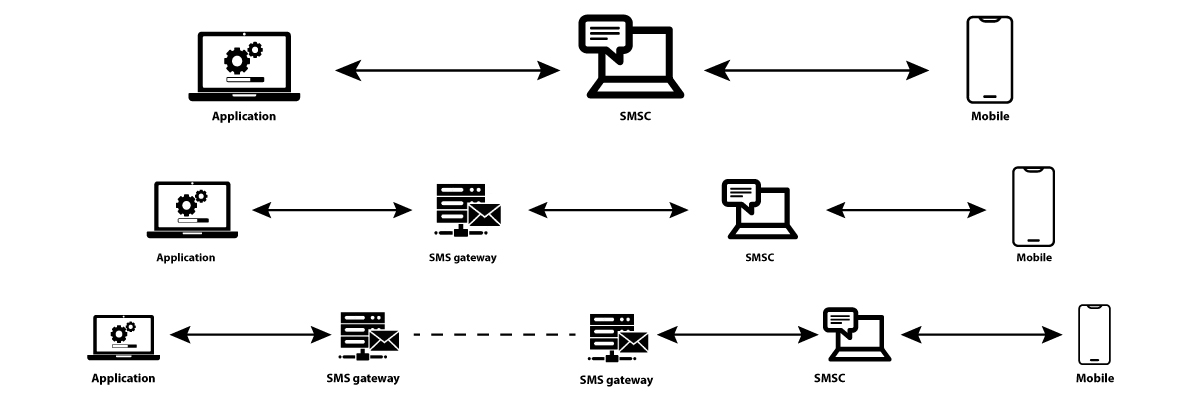
SMS Gateway is an indispensable part of the SMS sending and receiving process. Anyone, who is into a business that deals in SMS must have a thorough understanding of SMS Gateway. In this post, we are going to learn the various aspects of SMPP Gateway. Let’s get started:
Evolution of SMS Gateways
The very basic function of an SMS Gateway is to enable a computer system to send and receive SMS messages to and from an SMS-enabled device such as a mobile phone through the global telecommunication network. It performs the function of translation to make the sent messages compatible for delivery over the network and thus reach the recipient.
In simple words, we can say that SMS Gateways act as bridges between SMS applications and a mobile network’s SMSC i.e. Short Message Service Center.
In the early days, SMS Gateways were hardware-based equipment with SIM cards and embedded radios. However, modern-day SMS Gateways send SMS messages to telecommunication networks through an SMPP interface.
What is SMPP?
SMPP stands for Short Message Peer-to-Peer (SMPP) which is an industry-standard protocol that was developed to support the flexible transfer of SMS messages between ESME i.e. External Short Message Entities, Routing Entities, and SMSC i.e. Short Message Service Centers.
In view of today’s usage of the SMPP protocol, businesses use SMS-sending applications to execute their SMS marketing campaigns. These applications connect to SMS service providers using the SMPP protocol.
What is an SMPP Gateway?
We all know that SMS messages are created on mobile devices such as mobile phones and computer systems. These devices use GSM networks to send SMS messages and have ESMEs i.e. External Short Messaging Entities which are the starting and ending points of SMS. However, they cannot connect directly and this is where SMSC steps in. The SMSC performs the function of storing and forwarding messaging to and from ESMEs. In order to complete the process of receiving and transmitting SMS messages, a protocol such as SMPP is required.
SMPP is used by SMS Gateways as an access protocol. It is quite popular and preferred because it is able to support sending and receiving of SMS messages that are sent in huge volumes or in bulk form. Other protocols used in the SMS industry include HTTP, SMTP, and XML.

An application can communicate with a mobile using SMPP between the application and the nearest SMSC through the following ways, as shown in the above figure:
So an SMS Gateway that uses SMPP Protocol is called an SMPP SMS Gateway. In other words, we can also say that an SMPP gateway is an SMS delivery software that is installed on the computer of the company or business sending SMS messages.
The computer of the business that is sending the messages is called the SMPP client. The computer of the service provider, who is responsible for delivering the SMS messages to the mobile network is called the SMPP server.
 SMPP connection between a computer and the SMSC
SMPP connection between a computer and the SMSC
Things to Consider When Choosing an SMPP SMS Gateway
When it is about choosing an SMS gateway provider, it is crucial to check the performance and level of SMPP support as it can vary significantly between different SMS Gateway Providers. It is important to note that a reputed and reliable provider will always provide a Protocol Implementation Conformance Statement (PICS) describing the level of their SMPP support. Some other important things to consider are:
- Support for character set
- Delivery latency
- Retry Profile
How can a Business Set Up an SMPP SMS Gateway?
You’ll need the following information to set up your SMPP Gateway from your service provider:
- IP address or hostname of the SMPP service
- Port number of the SMPP service
- User name or the SMPP system ID
- Password
How to Start Using an SMPP Gateway?
In order to get started with an SMPP Gateway, Sender ID i.e. the phone number or the name of the sender which will be displayed on the receiver’s mobile, is required. It can be in various forms such as:
- Any phone number
- An alphanumeric sender ID
- A long code or a short code
There are various ways with which you can choose your sender ID; it depends on one provider and another.
Start your Bulk SMS Business Fast & Easy
REVE SMPP SMS Gateway is a really intuitive and user-friendly SMS API that offers top-notch features along with the reliable support that you need to build your SMS business. This enterprise-grade A2P Messaging Platform deploys the best routing process in the industry that ensures the successful delivery of messages and minimum failovers. You can even get real-time statistics about your business performance so that you can make strategic decisions for efficient management of services.
If you are looking forward to selling wholesale SMS messaging to enterprises, SMS hubs, SMS aggregators, and carriers, then REVE SMS Gateway is the ideal solution for you. Do get in touch with us to start within minutes!






















